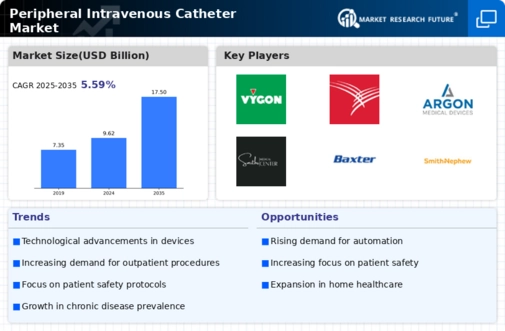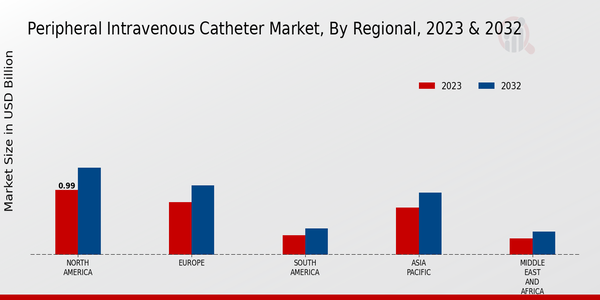Market Growth Projections
The Global Peripheral Intravenous Catheter Market Industry is projected to experience robust growth over the next decade. With a market value of 9.62 USD Billion in 2024, it is anticipated to reach 17.5 USD Billion by 2035, reflecting a compound annual growth rate of 5.59% from 2025 to 2035. This growth trajectory underscores the increasing reliance on peripheral intravenous catheters in various healthcare settings. Factors such as technological advancements, rising healthcare expenditures, and an aging population are likely to drive this expansion, positioning the market for continued success in the coming years.
Increasing Focus on Patient Safety
The Global Peripheral Intravenous Catheter Market Industry is significantly influenced by the growing emphasis on patient safety within healthcare settings. Hospitals and clinics are increasingly adopting protocols that prioritize the prevention of catheter-related infections and complications. This shift is reflected in the rising demand for high-quality, safety-engineered catheters that minimize risks associated with intravenous therapy. As healthcare providers strive to enhance patient outcomes, the market is projected to reach 17.5 USD Billion by 2035. This focus on safety not only aligns with regulatory standards but also fosters trust among patients and healthcare professionals alike.
Rising Incidence of Chronic Diseases
The Global Peripheral Intravenous Catheter Market Industry is significantly impacted by the rising incidence of chronic diseases, such as diabetes and cardiovascular conditions. These diseases often require long-term intravenous therapy, thereby increasing the demand for peripheral intravenous catheters. As the global population continues to age, the prevalence of these conditions is expected to rise, further driving market growth. This trend is indicative of a broader shift in healthcare needs, where effective management of chronic diseases becomes paramount. Consequently, the market is poised for substantial growth, reflecting the urgent need for reliable intravenous solutions in patient care.
Rising Demand for Healthcare Services
The Global Peripheral Intravenous Catheter Market Industry experiences a notable surge in demand for healthcare services, driven by an aging population and increasing prevalence of chronic diseases. As the global population ages, the need for effective intravenous therapies rises, leading to a projected market value of 9.62 USD Billion in 2024. This trend is further amplified by advancements in medical technology, which enhance the efficacy of peripheral intravenous catheters. Consequently, healthcare facilities are increasingly adopting these devices to improve patient outcomes and streamline treatment processes, thereby contributing to the overall growth of the market.
Expansion of Healthcare Infrastructure
The expansion of healthcare infrastructure globally contributes to the growth of the Global Peripheral Intravenous Catheter Market Industry. Emerging economies are investing heavily in healthcare facilities to accommodate the rising demand for medical services. This investment leads to the establishment of new hospitals and clinics, which in turn increases the need for peripheral intravenous catheters. As healthcare systems evolve, the availability of advanced medical technologies becomes more widespread, facilitating the adoption of innovative catheter solutions. This trend is expected to drive market growth as healthcare providers seek to enhance their service offerings and improve patient care.
Technological Advancements in Catheter Design
Innovations in catheter design play a pivotal role in shaping the Global Peripheral Intravenous Catheter Market Industry. The introduction of safety-engineered devices, which minimize the risk of needlestick injuries, has gained traction among healthcare professionals. These advancements not only enhance patient safety but also improve the efficiency of intravenous therapy. As a result, the market is expected to witness a compound annual growth rate of 5.59% from 2025 to 2035. The integration of materials that reduce catheter-related complications further supports the expansion of this market segment, as healthcare providers prioritize both patient care and operational efficiency.








